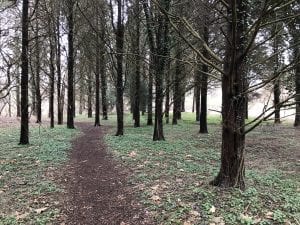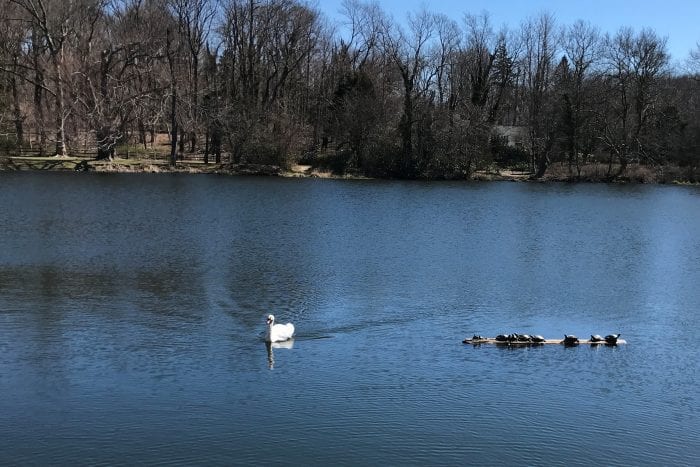Three Village Historian Pays Tribute to Setauket Park
By Beverly C. Tyler
The intersection of Main Street and Old Field Road in Setauket marks the entrance to the Frank Melville Memorial Park and Sanctuary. The horseshoe-shaped park, completed in 1937, includes extensive plantings, a simulated grist mill, a magnificent view of Conscience Bay and the cottage of the last Setauket miller Everett Hawkins. From the park, there is an entrance to the Frank Melville Memorial Foundation Sanctuary grounds with its extensive nature paths.

Just after dawn, the Setauket Mill Pond shimmers with morning mist and reflects the early morning sky. Walking along the path in the Frank Melville Memorial Park, the only sounds, except for the occasional car going by, are the birds in the trees and the ducks in the pond. They contrast with the greens, browns and grays of early morning. The contemplative surroundings start the day with the beauty of God’s creation and give perspective to the rest of the day.
I walk the park almost every day. I often stop at one or another of the many benches that line the park and face the lower mill pond. From that perspective, I see what I don’t take in while walking.
At first, the pond surface is like glass reflecting the bare brown trees, their branches forming interlacing patterns against the clear blue sky. Then a gentle breeze turns the pond to silver, moving it with patterns of dark and light. I notice walkers strolling along the path, their bright jacket colors contrasting with the brown shades of old gnarled black birch, white birch and evergreens. One variety of the rhododendrons along the path shows a few beginning buds. The forsythia, the park’s first spring color, is already showing yellow blooms. The dark evergreens, planted almost 80 years ago as mature trees, add vertical splendor climbing skyward.
As I walk, I hear the background sounds of water flowing over the mill dam and into the bay. A pair of mallards glides slowly across the pond occasionally dipping their beaks into the water. Suddenly a mallard glides down to the pond, his wings flapping to slow him down and his feet striking the pond and creating a spray of water. The trumpet calls of geese announce flight as they fly over the Old Field Road bridge, then across the mill dam and into Conscience Bay.
Almost every day I watch a swan glide slowly under the bridge and into the lower pond. Within a few minutes, he suddenly rises just above the water and with wings slapping the surface of the pond, creating a staccato of sound, flies to the north end of the pond near the island and then glides around the lower pond exercising his authority over ducks and geese.
Last month, my wife and I spent an early spring afternoon in the park and sanctuary. We walked into the park past the Setauket Post Office with its Greek Revival columns topped by corn cob capitals. Spring colors were just beginning to emerge along the one-third mile path around the lower mill pond. Together we turned off the horseshoe path and walked past the red barn and the new fencing that marks the entrance to the park sanctuary. We chose one of the middle paths that led into the woods and we were suddenly surprised by a grove of conifers between the path and the Bates House parking lot. There is almost no undergrowth at this time of year and with several trees and bushes removed or cut back the evergreens look spectacular. We continued along the wood chip paths and were delighted by the looks of the bare trees, shrubs and evergreens surrounding us and with the smell of red cedar as we walked.
This is a wonderful time of year to be in the park and especially to wander along the sanctuary pathways. It is impossible to get lost here as all the pathways are circular and you end up at either the red barn at the park or the Bates House at the end of Bates Road. It is also easy to stay a safe distance from other walkers, especially in the sanctuary.
The area around the Setauket Millpond was a center of commerce for the community from the time it was settled in 1655 until early in the 20th century. It is easy to imagine almost any time in Setauket history while in the park. Looking out over the mill dam, Conscience Bay reflects the 8,000 years the Native Americans lived here before the English settlers came to Setauket. The mill tells the story of the farmer grinding grain in the 1700s. The recently restored red barn was originally made from World War One barracks buildings at Camp Upton in Yaphank. The stable is a reminder of the white horse “Smokey” from the 1950s who would always come to the fence for half an apple. The stone bridge relates how an immigrant’s great-grandson, Ward Melville, came to Setauket and gave us an image of the countryside of rural England and Europe with a park and sanctuary.
Beverly C. Tyler is a Three Village Historical Society historian and author of books available from the society at 93 North Country Road, Setauket. For more information, call 631-751-3730 or visit www.tvhs.org.







